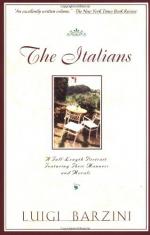When the major-domo had performed those mysteries intrusted to him, attendant giants threw open folding doors at the farther end of the court, and the bright visions disappeared into a long gallery on the ground-floor, painted in brilliant frescoes, to the reception-room. The suite of rooms on the ground-floor are the summer apartments, specially arranged for air and coolness. Rustic chairs stand against walls painted with fruit and flowers, the stems and leaves represented as growing out of the floor, as at Pompeii. The whole saloon is like a parterre. Settees, sofas, and cozy Paris chairs covered with rich satins, are placed under arbors of light-gilt trellis-work, wreathed with exquisite creepers in full flower. Palms, orange and lemon trees, flowering cacti, and large-leaved cane-plants, are grouped about; consoles and marble tables, covered with the loveliest cut flowers.
Near the door, in the first of these floral saloons where sweet scents made the air heavy, stands the Countess Orsetti. Although she had certainly passed that great female climacteric, forty, a stately presence, white skin, abundant hair, and good features treated artistically, gave her still a certain claim to matronly beauty. She greets each guest with compliments and phrases which would have been deemed excessive out of Italy. Here in Lucca, where she met most of her guests every day, these compliments and phrases were not only excessive, but wearisome and out of place. Yet such is the custom of the country, and to such fulsome flattery do the language and common usage lend themselves. Countess Orsetti, therefore, is not responsible for this absurdity.
Her son is beside her. He is short, stout, and smiling, with a hesitating manner, and a habit of referring every thing to his magnificent mamma. Away from his mamma, he is frank, talkative, and amusing. It is to be hoped that he will marry soon, and escape from the leading-strings. If he marries Teresa Ottolini—and it is said such a result is certain—no palace in Lucca would be big enough to hold Teresa and the countess-mother at one time.
Group after group enters, bows to the countess, and passes on among the flowers: the Countess Navascoes (with her lord), pale, statuesque, dark-eyed, raven-haired—a type of Italian womanhood; Marchesa Manzi—born of the noble house of Buoncampagni—looking as if she had walked out of a picture by Titian; the Da Gia, separated from her husband—a little habit, this, of Italian ladies, consequent upon intimacy with the jeunesse doree, who prefer the wives of their best friends to all other women—it saves trouble, and a “golden youth” is essentially idle. This little habit, moreover, of separation from husbands does not damage the lady in the least; no one inquires what has happened, or who is in the wrong. Society receives and pets her just the same, and, quite impartial, receives and pets the husband also.—Luisa Bernardini,




